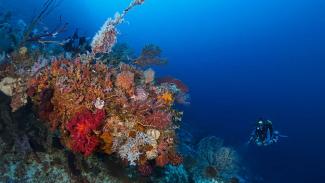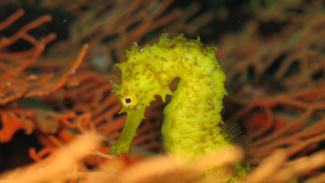Be a fish detective!

Christian Gloor
For many divers the thrill of spotting and identifying a new fish is one of the reasons they love to dive.
But identifying a new fish is never that easy, especially considering the sheer abundance of different species that make their home in Asia's incredible reefs.
So we've put together some tips to help you to improve your identification skills and get more out of your diving.

Top identification tips
Get familiar with the common reef fish families (or just your favourites) and find out about their appearance and behaviour. Underwater Asia's Reefspotter pages are a great place to start. With a bit of knowledge it’s easy to correctly identify most fishes families and it is much easier to ID a fish if you know which family it is from.
- Carry a slate underwater and make a quick drawing of the fish when you see it. Don’t worry about artistic perfection - just make a quick note of the shape, fins, markings and colouration of the fish.
- Don’t just look at the fishes' appearance, note it’s behavoiour as well. What the fish is doing can be just as helpful as what it looks like when you are trying to identify it. Is it on the bottom or hovering above the reef? Is it on its own or in a group? How does it swim and which fins does it use?
- The slate below gives you an idea of what to look out for to help you identify a fish more easily.
- Try and look for your fish in a fish book as soon after the dive as possible. Memories fade fast, especially when confronted with a page of 10 very similar looking reef fish.
- Don't place too much importance on common names. If you look a fish up in two different books, the chances are it will have different names, so if you want to compare between books - use the latin name instead.

Nick Hobgood

Platyax Tiera
You might also enjoy...
The coral reef recipe
Coral Reefs are the most complex and productive of all eco-systems on earth. As divers, we often marvel at the incredibly beautiful and complicated coral reef structures we see and maybe wonder how how they came to be. They have been created over many thousands of years using a complex, unique combination of ingredients and circumstances.
Here is nature's incredible recipe...
Getting technical
Christian Gloor
Have you ever found yourself diving on a reef wall and wondering what lurks in the depths below? Or longed to spend more than a few fleeting moments exploring a mysterious & historic shipwreck?
Then maybe technical diving is the sport for you. Increasing numbers of divers, eager to explore beyond the bounds of recreational limits, are taking an interest in technical diving.
Conservation matters
With almost 100,000 sq km of coral reefs, 51 different species of mangrove and 23 species of sea-grass, South-east Asia supports the most diverse collection of life on earth.
Unfortunately, this kaleidoscope of life may be on the brink of collapse. The consequences of human activity are putting pressure on this environment & its inhabitants every day, with south-east Asia's reef considered to be the most threatened on earth.
Perhentian Islands
Off the north-eastern coast of Peninsular Malaysia, not too far south of the Thai border, the beautiful Perhentian Islands rise vertically out of the sparkling blue sea, creating one of Malaysia's most iconic diving destinations & one of the most popular spots in Malaysia to learn to dive.
Get Involved
Brian Yurastis







